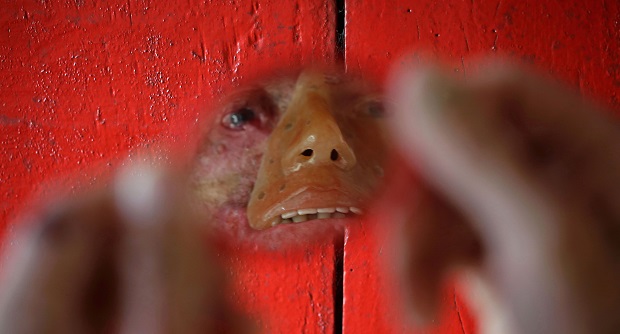Rare disease afflicts Brazilian village

In this March 3, 2014 photo, Djalma Antonio Jardim who has a rare inherited skin disease known as xeroderma pigmentosum, or “XP,” looks in a mirror at his home in the Araras community of Brazil’s Goias state. In an effort to camouflage how the disease has eaten away the skin on his lips, nose, cheeks and eyes, Jardim wears a rudimentary orange-tinted mask, its stenciled-in right eyebrow not matching his bushy real one that remains. AP
ARARAS, Brazil— This is a village where the people melt away.
Tucked into the sunbaked rolling hills of Brazil’s midwest, Araras is home to what is thought to be the largest single group of people suffering from a rare inherited skin disease known as xeroderma pigmentosum — or “XP.”
Those with the disease are extremely sensitive to ultraviolet rays from sunlight and highly susceptible to skin cancers — it robs victims of the ability to repair the damage caused by the sun.
That’s a particularly vexing burden in Araras, a tropical farming community where outdoor work is vital for survival.
“I was always exposed to the sun — working, planting and harvesting rice and caring for the cows,” said Djalma Antonio Jardim, 38. “As the years passed my condition got worse.”
Article continues after this advertisementAgriculture is no longer a real option for Jardim. He survives on a small government pension and meager earnings from an ice cream parlor he runs.
Article continues after this advertisementXP shows early signs that it has taken hold of its victims.
Jardim says he was just 9 when a large number of freckles and small lumps started appearing on his face — the tell-tale signs that experts say signal XP is present in children and call for serious precautions to be taken to protect them against the sun.
Such precaution wasn’t taken for Jardim, who now wears a large straw hat in an effort to protect his face. But it’s helped little. He has undergone more than 50 surgeries to remove skin tumors.
In an effort to camouflage how the disease has eaten away the skin on his lips, nose, cheeks and eyes, Jardim wears a rudimentary orange-tinted mask, its stenciled-in right eyebrow not matching his bushy real one that remains.
Beyond skin damage and cancers that XP patients get, about one in five may also suffer from deafness, spastic muscles, poor coordination or developmental delays, according to the U.S.-based National Cancer Institute.
More than 20 people in this community of about 800 have XP. That’s an incidence rate of about one in 40 people — far higher than the one in 1 million people in the United States who have it.
For years, nobody could tell Jardim or the others what was afflicting them.
“The doctors I went to said I had a blood disorder. Others said I had a skin problem. But none said I had a genetic disease,” Jardim said. “It was only in 2010 that my disease was properly diagnosed.”
Experts say Araras has such a high incidence rate because the village was founded by only a few families and several were carriers of the disease, meaning it was passed to future generations as villagers intermarried.
For instance, both of Jardim’s parents were carriers of the defective gene that causes the disease, largely ensuring he would have it.
Gleice Francisca Machado, a village teacher whose 11-year-old son, Alison, has XP, has studied its history in the area and says she found cases of people having the disease going back 100 years. She has started an association that educates locals about XP and tries to get parents to take extra care for their children, even if they may not have outward signs of the illness themselves.
“The sun is our biggest enemy and those affected must change day for night in order live longer,” Machado said. “Unfortunately, that is not possible.”
RELATED STORIES
DOH appeals for media responsibility amid flesh-eating disease hoax